-
 Since the defeat of the Spanish Armada in 1588, the British people have confronted no greater threat to their freedom than in 1940, when Hitler's armies swept through France in a few scant weeks and stood poised twenty-one miles from Dover. Had the Luftwaffe then gained air supremacy over the English Channel, nothing could have prevented the first invasion of Britain in over 900 years. This is the story of how Britain turned the prevailing tide, against all the odds - and won the day. Illustrated with photographs from private collections, drawings, diagrams and charts that clarifies the day by day events on both sides accompanied by text from witnesses and combatants that evoke those few desperate weeks of human endeavour and how the delicate balance was tipped - only just - in Britain's favour.
Since the defeat of the Spanish Armada in 1588, the British people have confronted no greater threat to their freedom than in 1940, when Hitler's armies swept through France in a few scant weeks and stood poised twenty-one miles from Dover. Had the Luftwaffe then gained air supremacy over the English Channel, nothing could have prevented the first invasion of Britain in over 900 years. This is the story of how Britain turned the prevailing tide, against all the odds - and won the day. Illustrated with photographs from private collections, drawings, diagrams and charts that clarifies the day by day events on both sides accompanied by text from witnesses and combatants that evoke those few desperate weeks of human endeavour and how the delicate balance was tipped - only just - in Britain's favour. -
 More and more Australians are reflecting on the soldiers who helped shape our nation. Many are choosing to make pilgrimages to the battlefields of our history, to bring to life names like the Somme, Passchendaele and Ypres. This is the essential companion for anyone visiting the Western Front, presenting well-illustrated walking tours across fourteen of the most important battlefields on easily accessible walking routes, it points out to readers the battlefield landmarks that still exist - the memorials to the men who fought there and the cemeteries where many of them still lie. There are moving quotes and black and white illustrations revealing the experiences of war from the common Aussie digger together with easy-to-follow- directions that allows anyone to visit the battlefields and walk in the footsteps of the first ANZACS.
More and more Australians are reflecting on the soldiers who helped shape our nation. Many are choosing to make pilgrimages to the battlefields of our history, to bring to life names like the Somme, Passchendaele and Ypres. This is the essential companion for anyone visiting the Western Front, presenting well-illustrated walking tours across fourteen of the most important battlefields on easily accessible walking routes, it points out to readers the battlefield landmarks that still exist - the memorials to the men who fought there and the cemeteries where many of them still lie. There are moving quotes and black and white illustrations revealing the experiences of war from the common Aussie digger together with easy-to-follow- directions that allows anyone to visit the battlefields and walk in the footsteps of the first ANZACS. -

Munda Trail: Eric Hammel
$10.00The Solomon Island archipelago stretches in a roughly east-west direction from New Guinea to San Cristobal. For the Imperial Japanese forces in 1942, it was a natural highway into the South Pacific. When checked at Guadalcanal, these forces realized they had moved east too quickly, and that their defeat was caused in part by inadequate air bases between the front and their head-quarters at Rabaul, more than six hundred miles away. As the last Japanese battalions were wrecking themselves against the Marine defensive perimeter on Guadalcanal, the decision was made to build the Munda airfield on New Georgia, right in the middle of the Solomons chain. This is the dramatic, harrowing story of green American soldiers encountering for the first time impenetrable swamps, solid rain forests, invisible coconut-log pillboxes, tenacious snipers tied into trees, torren-tial tropical rains, counterattack by enemy aircraft and naval guns, and the logistical nightmare of living and moving in endless mud. -
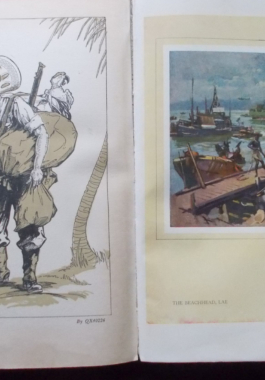
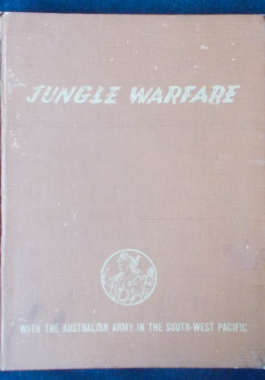
Published for the Australian Military Forces by the Australian War Memorial, Canberra, in 1944. Full of sketches, poems, colour plates and photographs, cartoons and jokes, as well as those fabulous yarns that Aussies can tell so well - and all by the service personnel who were engaged in the South West Pacific during World War II. Contributors are identified only by their service numbers...so your grandfather or great grandfather may be among the authors. Here we do not find battle statistics, plans or generals - just the down to earth Australian Diggers.
-
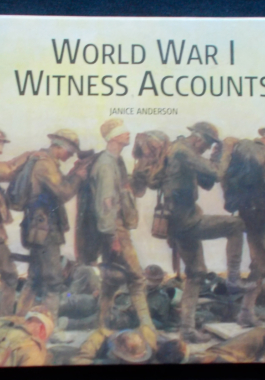 You can read history - or you can learn history from the people who lived it. This compilation of accounts of life during the First World War are from diaries and letters: from those at home, from the trenches, from men and women in the armed forces...there's even a section devoted to the modern machineries of war and what those on the front line thought of them. Here are the voices of that time and they are the ones who know what life was like then.
You can read history - or you can learn history from the people who lived it. This compilation of accounts of life during the First World War are from diaries and letters: from those at home, from the trenches, from men and women in the armed forces...there's even a section devoted to the modern machineries of war and what those on the front line thought of them. Here are the voices of that time and they are the ones who know what life was like then. -
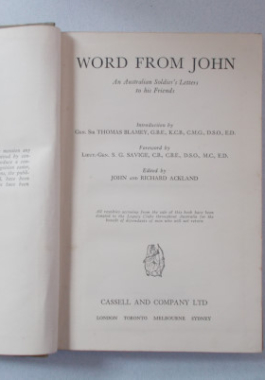
An Australian soldier's letters to his friends from World War II. When written, these letters did not mention place names other than those permitted by the censor. In order to make a continuous and intelligible narrative, these place names (now permitted) have been inserted. A rare glimpse from the war front.
-
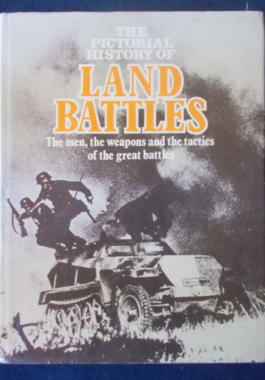 A book full of information, pictures and maps of land battles throughout history that proves it was not always about who had the biggest army. In this volume - Metaurus - after the toughest forced march in history, Nero slays Hasdrubal; Agincourt - massed archers and infantry slaughter the French cavalry; Bunker Hill - a thousand farmers ignite the flame of American independence; Austerlitz - Napoleon crushes an army bigger than his own; Balaclava - a battle of idiocy and sheer courage; Second Bull Run - a high spot for the South in the American Civil War; The Somme - slaughter on a scale never seen before or since; Cambrai - tanks explode into action for the first time; Gazala - Rommels' fast moving tactical brilliance; Stalingrad - Hitler's obstinacy leads the Wehrmacht to disaster; Cassino and Anzio - Allied forces combine to force a breakthrough; The Battle Of The Bulge - fast moving Panzers against Eisenhower, Montgomery and Patton; Operation Commando - a true 'United Nations; against the Chinese in Korea. Illustrated with archival photographs, artists' representations and maps.
A book full of information, pictures and maps of land battles throughout history that proves it was not always about who had the biggest army. In this volume - Metaurus - after the toughest forced march in history, Nero slays Hasdrubal; Agincourt - massed archers and infantry slaughter the French cavalry; Bunker Hill - a thousand farmers ignite the flame of American independence; Austerlitz - Napoleon crushes an army bigger than his own; Balaclava - a battle of idiocy and sheer courage; Second Bull Run - a high spot for the South in the American Civil War; The Somme - slaughter on a scale never seen before or since; Cambrai - tanks explode into action for the first time; Gazala - Rommels' fast moving tactical brilliance; Stalingrad - Hitler's obstinacy leads the Wehrmacht to disaster; Cassino and Anzio - Allied forces combine to force a breakthrough; The Battle Of The Bulge - fast moving Panzers against Eisenhower, Montgomery and Patton; Operation Commando - a true 'United Nations; against the Chinese in Korea. Illustrated with archival photographs, artists' representations and maps. -
 A volume of military activity, weaponry and technology from 1987. Arenas of activity covered: The Middle East - Tripoli; Lebanon; the Gulf War; South Yemen and the Arab-Israeli conflict. Europe, North America and the Soviet Union: Terrorism and Power Politics; The Superpower Relationship; NATO and the Warsaw Pact; International Terror; Northern Ireland. Asia - Islam's Guerrillas; The Tamil Tigers; The Philippines; Vietnam and Cambodia' Sikh Separatists. Africa - South Africa; Mozambique; Angola; Chad; The Sudan; Ethiopia; The Boy Soldiers of Uganda. Latin America: Guerrillas and Contras; El Salvador; Nicaragua; Peru; Chile. Military Technology: The War Machine; Aerial Warfare; Space and Missiles; Land Warfare; Naval Warfare. A wealth of information for the war history buff with plenty of colour photographs.
A volume of military activity, weaponry and technology from 1987. Arenas of activity covered: The Middle East - Tripoli; Lebanon; the Gulf War; South Yemen and the Arab-Israeli conflict. Europe, North America and the Soviet Union: Terrorism and Power Politics; The Superpower Relationship; NATO and the Warsaw Pact; International Terror; Northern Ireland. Asia - Islam's Guerrillas; The Tamil Tigers; The Philippines; Vietnam and Cambodia' Sikh Separatists. Africa - South Africa; Mozambique; Angola; Chad; The Sudan; Ethiopia; The Boy Soldiers of Uganda. Latin America: Guerrillas and Contras; El Salvador; Nicaragua; Peru; Chile. Military Technology: The War Machine; Aerial Warfare; Space and Missiles; Land Warfare; Naval Warfare. A wealth of information for the war history buff with plenty of colour photographs. -
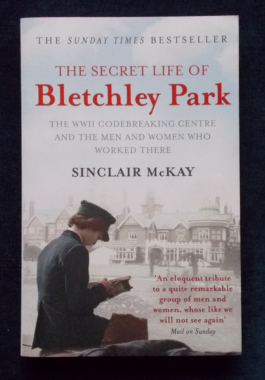 Bletchley Park was where one of Word War II's most famous and crucial achievements was made: the cracking of Germany's Enigma code in which its most important military communications were couched. This country house was home to Britain's most brilliant mathematical brains - including Alan Turing - and the scene of immense advances in technology...indeed, the birth of modern computing. The military codes deciphered there were instrumental in turning both the Battle of the Atlantic and the war in North Africa. Plenty has been written about the scientists and the code-breaking, in both fact and fiction, from Robert Harris and Ian McEwan to Andrew Hodges' biography of Turing. But what of the thousands of men and women who lived and worked there during World War II? This is not only a history of life at Bletchley Park; this is also an amazing compendium of memories from people now in their eighties of skating on the frozen lake in the grounds and the high jinks at nearby accommodation hostels - and of the implacable secrecy that meant girlfriend and boyfriend working in adjacent huts knew nothing about each other's work. Illustrated with black and white photographs.
Bletchley Park was where one of Word War II's most famous and crucial achievements was made: the cracking of Germany's Enigma code in which its most important military communications were couched. This country house was home to Britain's most brilliant mathematical brains - including Alan Turing - and the scene of immense advances in technology...indeed, the birth of modern computing. The military codes deciphered there were instrumental in turning both the Battle of the Atlantic and the war in North Africa. Plenty has been written about the scientists and the code-breaking, in both fact and fiction, from Robert Harris and Ian McEwan to Andrew Hodges' biography of Turing. But what of the thousands of men and women who lived and worked there during World War II? This is not only a history of life at Bletchley Park; this is also an amazing compendium of memories from people now in their eighties of skating on the frozen lake in the grounds and the high jinks at nearby accommodation hostels - and of the implacable secrecy that meant girlfriend and boyfriend working in adjacent huts knew nothing about each other's work. Illustrated with black and white photographs.


